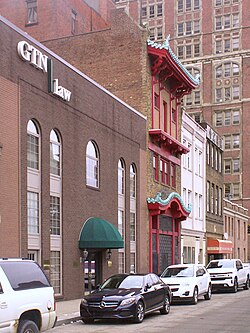Chinatown | |
|---|---|
 Chinatown Pittsburgh in 2020 | |
| Coordinates: 40°26′13″N79°59′51″W / 40.4369°N 79.9975°W | |
| Country | |
| State | Pennsylvania |
| County | Allegheny County |
| City | Pittsburgh |
| ZIP Code | 15219 |
| Area code | 412 |
The U.S. city of Pittsburgh, Pennsylvania, was home to a "small, but busy" Chinatown, located at the intersection of Grant Street and Boulevard of the Allies in Downtown Pittsburgh. From the mid-19th century into the early 20th century, Pittsburgh's Chinatown was home to a relatively-contained group of local commerce, grocery stores, and markets. Its Chinese American community resided in the surrounding blocks. [1] The neighborhood was mostly destroyed when construction on the Boulevard began in the 1950s. Only one Chinese restaurant remains. The On Leong Society was located there. [2] According to the article, "... the first Chinese community in Pittsburgh developed around Wylie Avenue above Court Place," according to a 1942 newsletter of the American Service Institute of Allegheny County. The Chinatown spread to Grant Street, and then "... to Water Street and then spread out to Second and Third avenues."



